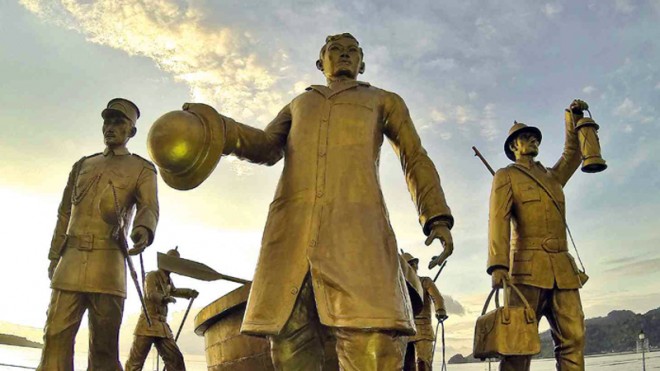Rizal’s life, works–and mystery–in book

EXILED RIZAL Statues depict the arrival of Dr. Jose Rizal in Dapitan City in Zamboanga del Norte province, where the national hero was exiled by the Spanish colonial government in 1892. The country observes Rizal’s 118th death anniversary Tuesday. NICO ALCONABA/INQUIRER MINDANAO
CALAMBA CITY, Philippines—Eriberto Saños, 49, has his hands full as Dec. 30 approaches. He prepares his house and food for some 20 guests coming for the day—the death anniversary of national hero Jose Rizal.
One of his special visitors is Baeng, who is in her 80s. Baeng, or Remigia Lagmay-Hibe, is the wife of Regalado Hibe, or Apo Nonong, the late leader and founder of Universal Rizalist Brotherhood Association Inc. (Urbai).
Urbai is a Rizalist group, registered in 1982 and currently has about 1,000 followers.
“Rizalista is a collective term” that refers to people with deep spiritual devotion to Rizal, Saños said. “But like any other religion, there are many types or sects (of Rizalistas), perhaps about 200 in the Philippines.”
In Calamba City, the birthplace of Rizal, there are about five different factions, of which the better known are Iglesia Watawat ng Lahi and Iglesia ng Lipi ni Gat Dr. Rizal.
The Saños residence is one of the many Rizalist temples or houses of prayers. It looks like any other average-income household in the lakeshore village of Sucol here with a tiled floor, neatly arranged furniture and pet dogs, and a small room on the third floor.
The room has an altar full of Rizal’s portraits among the statuettes of Mother Mary and Jesus Christ and its walls adorned with framed Rizal photos and unusual symbols, letters and figures. On the roof deck is a Rizal bust facing Mt. Makiling.
“Makiling is an encantada (fairy),” Saños said. “She, along with Arayat and Inang Sinukuan were the ones who handed the infant Rizal (to his parents).”
‘Pasyong Rizal’
In this room, Saños regularly lights a candle and says his prayers. But Dec. 30 and June 19, Rizal’s birth anniversary, are special occasions as Urbai members join the Saños family in reciting “Pasyong Rizal” for several hours on the eve of the anniversaries.
“Pasyong Rizal” is a 230-page book that Saños, who was born to a Catholic family, wrote and published in December 2011. It is similar to the traditional Catholic Pasyon, a narration of Christ’s passion, death and resurrection that devotees sing in marathon sessions during Lent.
Saños grew up listening to elders sing the Pasyon in his community. “Pasyon is a metrical romance so it should not be simply read aloud but has to be done with some art,” he said.
When he was in high school, Saños joined hikes to Mt. Banahaw in Quezon province, where his early exposure to different Rizalist groups started.
“I liked how they prayed so solemnly,” he said. “I thought, if we have the Pasyon for Christ, why not for Dr. Rizal, who is the Bathalang Ama (God the Father).”
Rizal’s life and works
“Pasyong Rizal” is divided into two parts. “The first is about Rizal’s life and works and the history of the Philippines and the second is the mysterious part,” Saños said.
Urbai basically believes in Rizal as God the Father; a Mother Mary, whom they call Bathalumang Inang Virgo (Holy Virgin Mother) Eva Celis Maria Purisima; Christ as the Holy Son; the Espiritu Santong Wagas (Pure Holy Spirit) and the Bathalang Omnipotente ang Kalangkap sa Dilim at Buong Liwanag (Omnipotent God Ruler over Light and Darkness).
One of their basic prayers, recited at 8 p.m. for 49 straight days for male Urbai members and 48 days for female members, is the Pagli-lima (Prayer to the Five).
“If you pray to just one or two of them, the power is weaker. You have to call on the five,” Saños explained.
Their prayers are also recited, both written in numbers and in the words, with the left hand placed on the chest and the right hand raised.
“Pasyong Rizal” tells of Rizal’s professions. “He is an anthropologist, botanist, cartographer and so on, completing (the alphabet) from A to Z,” Saños said.
It also refers to Rizal as a prophet, a healer, a linguist who spoke six dialects and 22 languages, and deals with several accounts of Rizal’s contemporaries who referred to him by titles as a Christ.
As a true god, “Rizal did not die when he was shot at Bagumbayan,” Saños said.
In “Pasyong Rizal,” Saños quoted a March 29, 1987, news report, which historian Ambeth Ocampo also found in the National Archives.
The document contained a report from an agent of the Spanish governor general that said a rose-colored cloud enveloped the carriage supposedly carrying Rizal’s body. When they looked, the soldiers did not find Rizal’s body inside, but instead a beautiful white cock.
Faith
Saños, who is married and has three children, is a licensed forester and is currently chief environment officer in Coron, Palawan. He is a proud believer of Rizalist ideas.
“Why will I be [ashamed]? A person can worship dirt and no one will stop him,” he said.
He said Rizalist beliefs are founded on history, Catholicism, environment and nationalist ideas.
Saños wrote “Pasyong Rizal” in hopes of uniting all Rizalist groups under one faith. Since 2011, he has been distributing copies of the book to members of other Rizalist groups.
“Even if I have to do it alone, I will. Ama (the Father) told me to do so,” he said.
Saño refuses to call his group a cult. He prefers to call it a “brotherhood.”
“It’s based on faith and nothing more. What will you gain from the members—they are the old, the poor and the uneducated. There is neither money nor fame, just faith,” he said.














